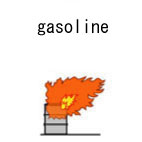| Case Name |
Fire of gasoline vapor during remodeling two gasoline tanks at the same time at an oil terminal |
| Pictograph |

|
| Date |
August 29, 2003 |
| Place |
Nagoya, Aichi, Japan |
| Location |
Oil terminal |
| Overview |
Construction was carried out at two adjacent tanks. One was involved in hot work. At the other tank, a manhole at the tank side was opened, and gasoline was drawn off. A fire occurred at this time. Six workers at both tanks were killed, and one person was injured. The gasoline vapor generated seemed to ignite during hot work. One mounted gas detector sounded, but it was too late. The cause of the accident seemed to be a construction management error. |
| Incident |
At an oil terminal, two gasoline tanks that were under construction were remodeled to inner float type tanks with a double roof structure from a cone roof type. Progress of construction of the two tanks was different. At the preceding No.24 tank, gasoline draw-off and purging had already finished, and hot-work started. However, at the other No.2 tank, draw-off work for gasoline had not yet finished. On that day, at No.2 tank, transfer of gasoline using a pump finished, a manhole was opened, and draw-off using a pneumatic pump and hose for transfer to a tank lorry started. The fire occurred at that time. A worker at No.24 tank evacuated because a gas detector mounted between No.2 tank and No.24 tank sounded. However, three workers died in the fire. Other three workers at No.2 tank working with oxygen masks were left after the fire broke out in the tank and died. |
| Processing |
Storage |
| Substance |
Gasoline |
| Type of Accident |
Fire |
| Sequence |
Gasoline was removed from No.24 tank about one month before, and there was no gasoline vapor in No.24 tank. No.24 tank was considered to be safe.
At No.2 tank, gasoline was scheduled to be drawn off from August 25th-30th, 2003.
10:00 on August 29th, the manhole of No.2 tank was opened, a hose was inserted, and extraction by a pneumatic pump started.
14:30, No.2 tank was almost empty, and water-rinsing started. The waste oil from water-rinsing was sucked in by a vacuum car.
About 15:40, a fire occurred near No.2 tank.
19:20, the fire was extinguished. |
| Cause |
The gasoline vapor generated near No.2 tank circulated around the tank's circumference, and the gas was ignited by a fire source during construction of No.24 tank. |
| Response |
There is no description of the activities of the private fire fighters in the report. The public fire brigade turned out and the fire was extinguished. |
| Countermeasures |
Fundamentally, details of construction are grasped every day, and it is necessary to consider a construction method and a schedule that are suitable. In the case of this accident, it should be necessary to stop hot work in the adjacent area as gasoline was released from the tank. |
| Knowledge Comment |
1. It is natural when light hydrocarbons such as gasoline are released into the atmosphere, combustible vapor is generated. This vapor spreads. At the opposite side of the manhole of the tank, the vapor also spreads. This is a basic point to be understood in handling a liquid with a low ignition point such as gasoline.
2. Safety countermeasures for the construction of hazardous facilities are primarily the responsibility of the owner. Even if the subcontractor is knowledgeable, the owner must have superior knowledge of hazardous substances and the situation in the facilities. |
| Background |
The cause was clearly a management system error. Draw-off work for light hydrocarbons at an adjacent tank was carried out with the manhole open. At the same time, hot work was carried out with a gas detector set up near an adjacent tank. There is a lack of risk management based on the prediction of the generation of gasoline vapor from gasoline draw-off work at an adjacent tank, or the generation of combustible gas from venting gas from another tank and drainage work, etc. There might have been a lack consciousness of the hazard and an insufficient grasp of the details of construction. |
| Incidental Discussion |
In the petroleum industry, integration and abolition of oil terminals is progressing for rationalization. It is desirable to maintain safety during such rationalization. |
| Reason for Adding to DB |
Example of fire in the tank yard caused due to insufficient safety countermeasures |
| Scenario |
| Primary Scenario
|
Poor Concept, Poor Strategy or Concept, Wrong Work Content/Schedule/Environment, Poor Value Perception, Poor Safety Awareness, Inadequate Risk Recognition, Misjudgment, Misjudgment of Situation, Dangerous Limit and Countermeasure, Planning and Design, Poor Planning, Poor Planning of Repair, Non-Regular Action, Inaction, Insufficient Safety Measure, Secondary Damage, External Damage, Fire, Bodily Harm, Death, 6 person died, Bodily Harm, Injury, Loss to Organization, Economic Loss, Loss to Organization, Social Loss, Trust Damage
|
|
| Sources |
Accident prevention technical center, Urgent report; Outline of factory fires that have occurred frequently. Safety & Tomorrow. No.92. pp.17-27 (2003)
Large-scale fire in August - September 2003, Fire. No.266, pp.5-7(2003)
Chunichi newspaper, (2003)
|
| Number of Deaths |
6 |
| Number of Injuries |
1 |
| Multimedia Files |
Fig2.Field figure (Chunichi Newspaper)
|
| Field |
Chemicals and Plants
|
| Author |
KOBAYASHI, Mitsuo (Office K)
TAMURA, Masamitsu (Center for Risk Management and Safety Sciences, Yokohama National University)
|
|